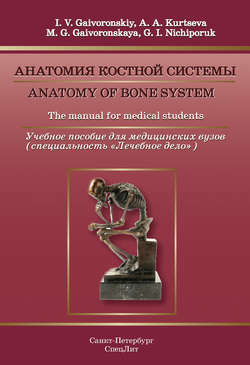Читать книгу Anatomy of bone system. The manual for medical students / Анатомия костной системы. Учебное пособие для медицинских вузов - Г. И. Ничипорук - Страница 4
1. GENERAL ОSTEOLOGY
ОглавлениеOsteology is the part of anatomy which studies bones. It is quite difficult to determine the exact number of bones, because their number changes with age. During life, more than 800 individual bony elements develop, 270 of them appear in the prenatal period, other ones appear after birth. The majority of individual bony elements fuse with each other, therefore the skeleton in an adult person contains only 206 bones (fig. 1.1). Apart from permanent bones, there may be inconstant (sesamoid) bones in mature age, their appearance is caused by specific features of the body structure and function.
Fig. 1.1. Human skeleton (frontal aspect):
1 – skull (cranium); 2 – vertebral column (columna vertebrale); 3 – clavicle (clavicula); 4 – IV rib (costa IV); 5 – sternum (sternum); 6 – humerus (humerus); 7 – ulna (ulna); 8 – radius (radius); 9 – carpal bones (ossa carpi); 10 – metacarpal bones (ossa metacarpi); 11 – phalanges of hand (ossa digitorum manus); 12 – ischium (os ischium); 13 – metatarsal bones (ossa metatarsi); 14 – tarsal bones (ossa tarsi); 15 – tibia (tibia); 16 – fibula (fibula); 17 – patella (patella); 18 – femur (femur); 19 – pubis (os pubis); 20 – ilium (os ilium)
The bones, together with their joints, form the skeleton of the human body. It serves as a place for start and attachment of muscles, provides protection of visceral organs and also carries out the formbuilding and some other major functions.
